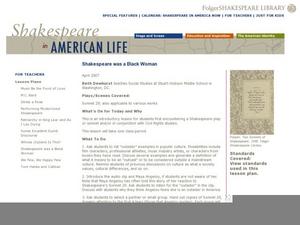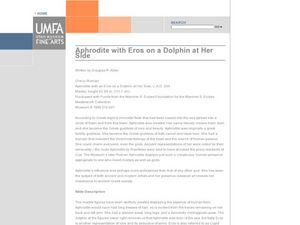Curated OER
Shakespeare Was A Black Woman
"I all alone beweep my outcast state." After a discussion of the "Shakespeare in American Life" segment in which Maya Angelou's relates her reaction to Sonnet 29, class groups create and perform a scene about an outcast that includes the...
Seussville
What Can Your Class Do?
Inspire scholars to do their part for planet Earth with a read-aloud of Dr. Seuss's The Lorax, and variety of activities designed to boost the environmental activist in us all. Activities include writing poems about the Earth,...
Curated OER
Bottled Water Ban
Convenience, taste, portability ... what's not to love about bottled water? Apparently, a lot. Scholars analyze the four main arguments supporting and opposing the sale of bottled water. They explore the health, environmental, and...
Curated OER
Breaking Barriers
Determine how African-Americans have broken barriers in this history lesson. Middle schoolers discuss the 15th Amendment and the American civil rights movement prior to analyzing Barack Obama's speech "A More Perfect Union," taking care...
K12 Reader
Civil Rights Biography: Dr. Martin Luther King, Jr.
Introduce your class to Dr. Martin Luther King, Jr. and his many accomplishments through a one-page biography. Class members read the text and respond to three questions included at the end.
K12 Reader
Civil Rights Biography: Rosa Parks
Add to your instruction on the civil rights movement with this biography of Rosa Parks. Class members read the one-page summary of her life, which focuses mainly on the part she played in the bus boycott. After reading, pupils respond to...
Curated OER
Who Knows? Your Privacy in the Information Age
Teach young adults how to become advocates for their privacy in the modern information age. In a series of five lessons, learners explore their beliefs and opinions about privacy vs. the actual laws regarding who has the right to access...
Curated OER
Ethos, Logos, and Pathos in Civil Rights Movement Speeches
Examine three speeches while teaching Aristotle's appeals. Over the course of three days, class members fill out a graphic organizer about ethos, pathos, and logos, complete an anticipatory guide, read speeches by Martin Luther King Jr.,...
Project Tahoe
Does the Use of Torture on Enemy Combatants Violate the 8th Amendment?
Tackle ethics in your high school history classes with a Socratic seminar about torture as a means for obtaining information. The plan allows for pupils to take the reins during the seminar. On the first day, class members read several...
Science 4 Inquiry
Eukaryotic Cells: The Factories of Life
Eukaryotes include humans, animals, and plants. Scholars learn about the parts of eukaryotic cells. They design models of a store and match the correct function of each part to the function of a part of the cell. They review their...
PBS
The Lorax
Accompany a reading of Dr. Seuss' tale, The Lorax, with a five-item worksheet. Questions challenge scholars to list characters' names, use text details to answer inquiries, and describe the moral of the story.
Curated OER
Human Acrostic Poem
For this acrostic poem worksheet, learners read about creating an acrostic poem, the complete one using the word "human." Worksheet contains links to additional activities.
Curated OER
Art Curators
Students use the Internet to select various works of art around a theme. They create a PowerPoint exhibit of these works and create the written documentation to accompany their presentation. They critique the class exhibits.
Curated OER
Art Smart
Young scholars consider the importance of arts programs in public schools, explore the disparities in arts programs in the New York City school system.
Curated OER
Building a Circulation City
Students identify the different organ systems found throughout the human body. Using a model, they explain and draw the flow of blood and name the parts of the circulatory system. They create their own circulation city in which to show...
Curated OER
International Institute of Archaeology an Anthropology
Students research early humans and their cultures. They conduct Internet research, discuss their findings with their group, evaluate the information provided by artifacts, and create a report to present to a simulated archaeology institute.
Curated OER
Picturing People
Pupils look at the varied ways the human body is portrayed in contemporary media. They discuss what a character is and how it plays a role in telling stories. Students look at examples of objects like dolls, puppets and toys that stand...
Curated OER
Mapping the Circulatory System
Students investigate the circulatory system in human beings. In this human body lesson, students create an outline of a human body using colored markers and butcher paper. Students use red and blue colors to simulate the...
Curated OER
Global Eyes
Twelfth graders consider global issues and their effects. They identify the themes of human needs, human rights, and the environment, select a topic and research articles for a Global Current Events Portfolio. Working in small groups,...
Curated OER
Can I Feel Your Pain? A Sculpture Project
Students conduct research dealing with some aspect of human rights in Latin America. They create a sculpture as a response to an instance of repression that touched them from their research. They give a brief oral report on their country.
Curated OER
"I Have the Right Club"
Students explore issues facing society today. In this social studies lesson, students discuss human rights concepts. Students discuss the role they play in promoting the idea of freedom.
Curated OER
F is for Fair!
Ninth graders examine their human right to education. For this American Government lesson, 9th graders evaluate how well the world is doing when it comes to providing a free, equal, quality education to our youth.
Curated OER
Aphrodite with Eros on a Dolphin at Her Side
Young scholars analyze Greek sculpture. In this Greek sculpture lesson, students review the roles and responsibilities of the Gods and Goddesses in the Greek pantheon. Young scholars compare the way Greek Gods are portrayed and sculpt...
Curated OER
Creating Artwork to Explain Environmental Change
Students review artwork that relates to the environment and communicates a value. They view and analyze art by Andy Warhol, Eric Carle and Albert Bierstadt and then create original pieces with an environmental theme.























